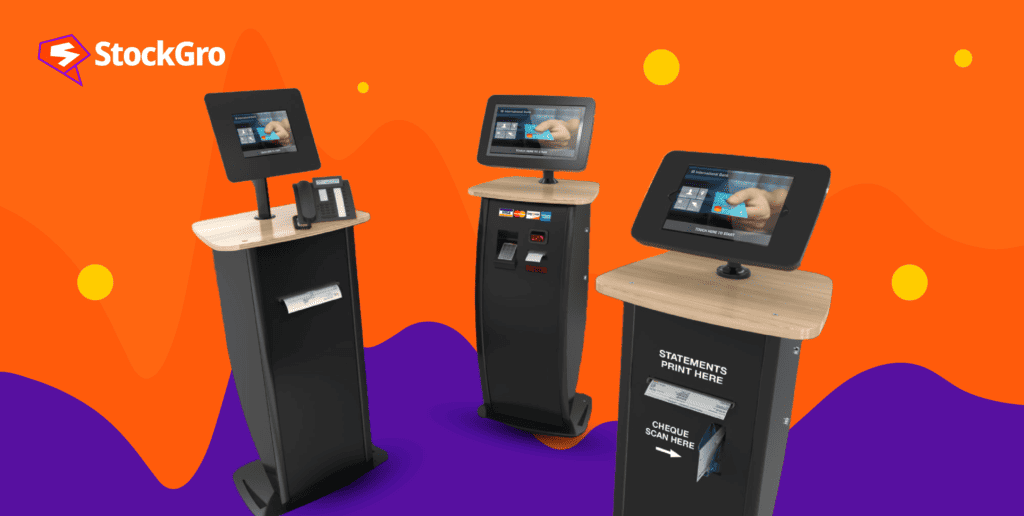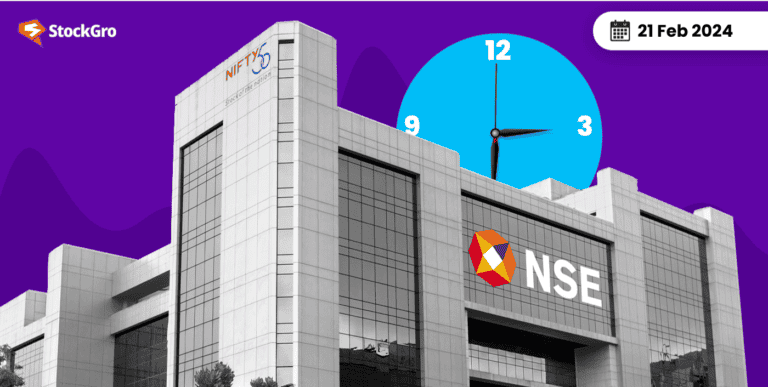
If you are searching for “Kiosk banking meaning” lately, let us tell you that it is only a type of banking service. India has adopted this neighbourhood banking concept to expand financial access to remote, rural populations without formal banking infrastructure.
By setting up transactional machines and service points in local shops, kiosk banking facilitates the unbanked. This article explains kiosk banking, how it works through customer service points and machines, how to apply it to offer services and key advantages like lower costs and convenience.
Continue reading to understand this critical financial inclusion initiative.
What is kiosk banking?
The Reserve Bank of India (RBI) launched kiosk banking as a programme to provide access to banking services in rural and remote parts of India. This is mainly because there isn’t an actual bank branch nearby.
Kiosk banking allows consumers, especially those in rural areas, to get financial services at a small kiosk rather than physically visiting a branch.
You may find these kiosks in neighbourhoods in all kinds of different places. In addition to handling people’s bank accounts effectively, they help people use banking services like cashing checks and carrying out other financial transactions. These are the two parts that make up kiosk banking in India.
Customer service point (CSP):
The shop’s kiosk booth and this counter are designed to work together to connect quickly to a public or private bank. Customers with questions or concerns about their accounts or transactions may contact CSP for assistance.
Kiosk machine:
The kiosk machine, the second component of the kiosk, lets customers deposit checks, check their balances, and do other banking-related operations. It is a fully functional banking facility machine. You can use this kiosk to do various banking transactions, including depositing cash or checks, printing passbooks, or checking your account balance.
When compared to more conventional banking options, kiosk banking offers several benefits. Customers prefer the convenience of having the ability to transact at their own pace and time. Not waiting in line at a teller counter also makes working easier. Since fewer employees are needed, it also helps banks save money on operational expenses.
Also read: Tax-efficient withdrawal strategies for retirement in India
How to apply for kiosk banking?
With the help of kiosks, your retail location can transform into a mini-bank, providing customers in the area with various kiosk banking services. More than that, they are convenient, quick, and have a wide range of banking features.
When launching a new kiosk banking system, keep the following in mind:
Look into the programme:
The bank CSP website has more information about the programme. Before applying, ensure you meet all the requirements and research the available services.
Figure out if you qualify:
Make sure you qualify for the programme by checking the eligibility criteria. A specific amount of education, a dedicated work area, a computer, and a printer might be required.
Fill out the application:
You can apply after you’ve verified your eligibility. Complete the application according to the website’s guidelines and submit all required documents.
Participate in training sessions:
You are required to attend training sessions if you are accepted into the programme. This will teach you the ins and outs of interacting with clients and using your mobile device or computer to process their payments.
Also read: Use these advanced budgeting techniques to save money/
Features of kiosk banking
Because its primary purpose is to serve LIGs (low-income groups), the kiosk banking system is straightforward in design and operation. Here are the main characteristics of kiosk banking:
- There is no standard minimum balance requirement for this type of bank account. They are authorised to open and manage a zero-balance bank account. Those who work for a daily wage and rely on that income will find this helpful.
- All transactions involving these individuals must be settled in cash.
- The account holder’s signature is not required to conduct cash transactions; thumb impressions are sufficient.
- Insurance is another perk that customers of kiosk banking receive. The account holder is authorised to have this coverage in the event of an accident.
- You can start saving or investing immediately with a fixed deposit or recurring deposit account from kiosk banking.
Advantages of kiosk banking
Streamlined operations:
Kiosks are automated counters. With self-service options, businesses can save money on labour costs by not having to hire attendants to run the kiosks.
Various skill sets:
Kiosk software can manage multiple basic tasks, reducing customers’ need to visit banks physically. Tellers can concentrate on more intricate duties requiring individual attention rather than processing deposits or money transfers.
Set minimum balance at zero:
The kiosk banking system allows the candidate to create a new bank account with a zero balance. You can use the bank’s services without worrying about having a minimum balance.
Thanks to this, low-income groups and those working for the minimum wage can open bank accounts and take care of them without stressing over their balances.
Contactless:
Many businesses have had to change their methods because of the pandemic. Without sacrificing efficiency or functionality, kiosks offer a contactless way to conduct business.
Reliability in serving customers:
When dealing with more conventional bank employees, customers may have vastly different experiences. However, kiosks contribute to a steady and usually positive experience, which can help maintain excellent client retention.
24/7 accessibility:
Because most kiosks are open 24/7, you can usually find one near you. It benefits those whose work schedules don’t align with typical banking hours. This makes them very convenient to use, even when you can’t access a bank branch.
Support in real-time:
The digital nature of banking kiosks makes them ideal for integrating software that connects customers needing personalised assistance with live tellers. Even though this technology isn’t exactly a cinch to implement everywhere, it’s definitely on the rise.
Also read: Overcoming Financial Setbacks: Tips for Recovery/
Kiosk Banking Security Measures
Kiosk banking is a modern, self-service banking solution that allows customers to perform various banking transactions without the need to visit a traditional branch. However, since it involves sensitive financial information, ensuring robust security is paramount. Here are some key security measures implemented in kiosk banking:
- Multi-Factor Authentication (MFA): Multi-factor authentication is often used in kiosk banking to enhance security. This involves verifying the identity of the user through two or more authentication factors, such as a PIN, fingerprint scan, or OTP (One Time Password). This additional layer of security ensures that only authorized individuals can access and perform transactions.
- Encryption of Data: All data transmitted through the kiosk banking system is encrypted to prevent unauthorized access during the transaction process. The encryption ensures that sensitive information, such as account details and transaction history, is protected from hackers or cybercriminals.
- Secure Network Connectivity: Kiosk banking machines are connected to secure networks that are regularly monitored to detect and prevent potential threats. These networks are often shielded by firewalls and intrusion detection systems to block unauthorized access and protect users’ information.
- Biometric Verification: Many kiosk banking systems incorporate biometric authentication, such as fingerprint or iris recognition, to verify a user’s identity. This adds an additional layer of protection against fraud, as biometrics are unique to each individual and difficult to replicate.
- Surveillance and Monitoring: Most kiosk banking locations are equipped with security cameras to monitor the environment and detect any suspicious activity. Continuous surveillance helps deter fraudulent activities and ensures that any potential security breaches are addressed in real time.
- Regular Software Updates and Patches: Kiosk banking systems are regularly updated with the latest software patches to address any vulnerabilities. This ensures that the system is protected against new threats and cyber-attacks. Regular updates help in maintaining a secure and stable environment for transactions.
- User Awareness and Education: Kiosk banking providers often educate users about the importance of securing their personal information and being vigilant while using kiosks. This includes warnings about leaving the machine unattended and not sharing PINs or passwords with anyone.
- Anti-Skimming Devices: Anti-skimming technology is used in many kiosk banking machines to prevent criminals from using illegal devices to steal card information. These devices help ensure that credit and debit card information remains secure during transactions.
By implementing these security measures, kiosk banking can provide a safe and convenient alternative to traditional banking, with reduced risk of fraud and unauthorized access.
Kiosk Banking vs Traditional Banking
Kiosk banking and traditional banking are both important services in the financial sector, but they differ in several key aspects, including accessibility, convenience, and customer experience. Here’s a comparison between the two:
1. Accessibility:
- Kiosk Banking: Kiosk banking provides round-the-clock access to banking services, allowing customers to perform transactions at any time of day or night. This is especially beneficial for customers who cannot visit bank branches during business hours or those living in remote areas.
- Traditional Banking: Traditional banking is typically restricted to the operating hours of the branch, which may vary depending on the location. While some branches offer extended hours, customers are still limited to these times for accessing in-person services.
2. Convenience:
- Kiosk Banking: Kiosks are designed to offer a high level of convenience with self-service options. Customers can withdraw cash, check account balances, deposit checks, transfer funds, and even pay bills without needing to interact with a bank teller.
- Traditional Banking: In traditional banking, customers need to wait in line to speak to a teller or customer service representative to complete transactions. While many banks offer online services, in-person visits are often required for more complex tasks, such as applying for loans or opening accounts.
3. Customer Interaction:
- Kiosk Banking: Kiosk banking is a self-service model where users interact directly with the machine, and customer support is usually available via a helpline or online chat if needed. While this offers autonomy, it lacks the personal touch that traditional banking provides.
- Traditional Banking: Traditional banking offers face-to-face interaction with bank officers and tellers. Customers can receive personalized service, ask questions, and get assistance for more complex issues, such as loan inquiries, financial planning, or dispute resolution.
4. Security:
- Kiosk Banking: Kiosk banking systems use advanced security measures such as encryption, biometric authentication, and multi-factor authentication to protect user data. However, since these are self-service machines, users must be vigilant about privacy and potential risks of fraud.
- Traditional Banking: Traditional banking is considered secure due to the presence of bank staff who can oversee transactions and offer assistance. However, this does not eliminate the risk of human error or fraud, especially if a customer is dealing with an untrustworthy employee or undergoing a scam.
5. Transaction Complexity:
- Kiosk Banking: Kiosk banking is ideal for completing simple, routine transactions such as cash withdrawals, balance checks, deposits, and transfers. More complex transactions, like opening an account or applying for a loan, typically require in-person visits to the bank.
- Traditional Banking: Traditional banking can handle both simple and complex transactions. Customers can open accounts, apply for loans, and seek advice on financial products. Personalized assistance is available for more complicated banking needs, making it more versatile for a wide range of services.
6. Cost:
- Kiosk Banking: Kiosk banking often reduces operational costs for banks, as fewer staff are needed to operate the services. These cost savings can be passed on to customers in the form of lower fees for certain banking services.
- Traditional Banking: Traditional banking requires a physical branch with employees, which involves higher operational costs. These costs are sometimes reflected in fees for services, which may be higher than those offered by kiosk banking.
7. Customer Experience:
- Kiosk Banking: The experience with kiosk banking can be quick and efficient, but it may feel impersonal to some customers. While it is convenient for routine tasks, it does not offer the same level of engagement and support as traditional banking.
- Traditional Banking: Traditional banking offers a more personalized and relationship-driven experience. Customers can engage with bank staff and receive tailored advice, which is especially important for complex financial needs.
Conclusion
Kiosk banking provides localised financial access, spanning services like deposits and withdrawals, to rural Indian communities through neighbourhood setups. Compared to conventional branches, appropriately designed localised kiosk networks reach more rural customers consistently through operational simplicity and cost savings.
Kiosk banking is the best option to avoid the hassle, wait, and inconvenience of going to the bank.

